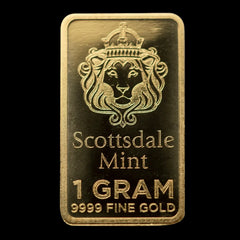Why Gold Shines in Today's Economy
Gold investment offers multiple pathways to protect and grow your wealth through precious metals. Here are your main options:
Physical Gold:
- Gold bars and coins you own directly
- Stored at home or in secure facilities
- Higher premiums but full ownership
Allocated Gold Products:
- Gold stored in professional vaults
- Lower transaction costs than physical
- Secure storage with direct ownership
Key Benefits:
- Hedge against inflation - Gold historically outpaces rising prices
- Portfolio diversification - Low correlation with stocks and bonds
- Safe-haven asset - Performs well during economic uncertainty
- Wealth preservation - Maintains purchasing power over time
The numbers tell a compelling story. The price of gold rose from around $300 per ounce in 2000 to over $2,500 per ounce in August 2024, according to recent market data. With central banks purchasing 900 tonnes forecasted for 2025 and J.P. Morgan Research expecting gold to reach $4,000 per ounce by 2026, the precious metal continues attracting institutional and individual investors alike.
Why now? Economic uncertainty, geopolitical tensions, and currency debasement fears drive demand for tangible assets. Gold plays four fundamental roles in modern portfolios: diversification, long-term returns, liquid asset with no credit risk, and overall performance improvement.
I'm Eric Roach, and I've spent over a decade guiding Fortune-500 clients through complex hedging strategies as an investment banking advisor in New York before focusing on helping individual investors steer gold investment opportunities. My Wall Street experience in risk management and market cycles now helps everyday investors use precious metals as a defensive strategy against economic volatility.

The Enduring Value of Gold in Your Portfolio
Think of gold as your portfolio's steady friend—the one who's been around for thousands of years and never lets you down when times get tough. While other investments come and go with the latest trends, gold investment has maintained its reputation as a reliable store of value throughout human history.
Gold's inflation-fighting power comes from a simple truth: you can't print more gold like you can with paper money. When governments fire up the printing presses and currencies lose their purchasing power, gold typically holds its ground. This scarcity makes it a natural hedge against inflation and currency debasement.
Here's where it gets interesting for your portfolio. Gold marches to its own drummer—it has a low correlation to stocks and bonds. When your stock portfolio takes a hit during market turbulence, gold often moves in the opposite direction or stays stable. Research shows that adding between 4% and 15% in gold to portfolios over the past decade would have actually improved risk-adjusted returns.
Central banks around the world are putting their money where their mouth is. Global central bank gold holdings now amount to nearly 36,200 tonnes—that's almost 20% of their official reserves, up from around 15% at the end of 2023. When the world's financial institutions are buying gold in bulk, it's worth paying attention.
The geopolitical stability factor can't be ignored either. Whether we're facing trade wars, military conflicts, or economic sanctions, investors consistently turn to gold as their go-to safe haven. Unlike stocks tied to specific companies or bonds linked to particular governments, gold's universal acceptance makes it a truly global store of wealth.
For a deeper dive into gold's fascinating journey through history, check out our guide on A brief history of gold as currency and store of value. You'll find how this precious metal has weathered empires, wars, and economic upheavals while maintaining its value.
Understanding Why Gold and Silver Understanding Their Value As Safe Haven Assets provides the modern context for why these metals still matter in today's digital world.
The institutional adoption story gets even more compelling when you learn about Why Central Banks Buy Gold And Why You Should Too A Look Into The Power Of Physical Gold. These aren't impulse purchases—they're strategic moves by the world's most sophisticated financial institutions.
Long-term returns tell the real story. While gold doesn't pay dividends or interest, its wealth preservation qualities shine over decades. It's not about getting rich quick—it's about making sure your wealth survives whatever economic storms lie ahead.
A Deep Dive into Your Gold Investment Options
When it comes to gold investment, you have several practical paths. The goal is to match the approach with your objectives, budget, and comfort level.
| Investment Type | Liquidity | Costs | Ownership | Storage | Risk Level |
|---|---|---|---|---|---|
| Physical Gold Bars | Medium | Premiums + Storage | Direct | Your responsibility | Low-Medium |
| Physical Gold Coins | High | Higher premiums | Direct | Your responsibility | Low-Medium |
| Allocated/Vaulted Gold | High | Storage fees | Direct | Professional | Low |
| Gold Jewelry | Low | Very high premiums | Direct | Your responsibility | Medium |
The common thread in every option Summit Metals offers is real ownership. Whether you keep coins at home or use our professional vaults, you’re holding tangible metal—not a paper promise.
The Pros and Cons of Physical Gold Investment

Pros
- Tangible asset you can hold
- Universally recognized value
- No counterparty risk
Cons
- Premiums over spot price (typically 3-8%)
- Ongoing storage/insurance costs if kept off-site
- Larger bars can be harder to sell in small increments
Understanding Spot Price Vs Premium How Precious Metals Pricing Works and The Ultimate Guide To Gold And Other Precious Metals Storage will help you manage these trade-offs.
Allocated and Vaulted Gold Products from Summit Metals

If you prefer convenience over home storage, Summit Metals offers fully allocated vault solutions:
- Your bars are individually identified and held in top-tier vaults.
- Lower transaction costs compared with many small retail purchases.
- 24/7 online access to view holdings and place sell orders during market hours.
- Insurance, security, and logistics handled by professionals for a modest annual fee (typically 0.12-0.48% of value).
Systematic buyers can start small with our gold savings plans, using dollar-cost averaging explained in The Strategic Approaches To Investing In Gold And Silver Dollar Cost Averaging And Value Averaging.
Whether you choose coins in hand or metal in a vault, Summit Metals ensures transparent, real-time pricing and authenticated products so you can invest with confidence.
Mastering the Market: Key Factors, Risks, and Due Diligence

Gold prices move for a handful of well-known reasons:
- Supply & demand: Mining output changes slowly, but investor and central-bank demand can surge in uncertain times.
- Interest rates: Higher rates make yield-bearing assets more attractive, while low rates level the playing field for gold.
- U.S. Dollar strength: A stronger dollar often pushes gold lower for non-U.S. buyers, and vice versa.
- Central-bank policy & money printing: Expansionary policy typically boosts the appeal of tangible assets.
- Geopolitics: Conflict, sanctions, or trade disputes send capital toward safe havens.
For deeper insight, explore Key Factors Influencing Gold Silver Prices Supply Demand Geopolitics and The Interplay Of Interest Rates The Dollar And Gold Prices.
Navigating the Risks of Gold Investment
Gold’s main drawbacks are its lack of income and the practicalities of storage and authentication. Counterfeit products and aggressive sales pitches are real dangers. Stick to reputable dealers, verify serial numbers, and consult resources like Identifying Reputable Bullion Dealers Avoiding Counterfeits.
The Federal Trade Commission on bullion investing offers additional consumer-protection tips.
With solid due diligence—research, proper storage, and buying from authenticated sources—gold can be a reliable pillar in your long-term financial plan.
Strategizing Your Gold Allocation
Think of gold as the steady teammate in your portfolio—rarely the MVP, but always on the court when volatility strikes. The key is to integrate it in a way that fits your risk tolerance, investment horizon, and existing mix of assets.
- Diversification: Gold’s low correlation with stocks and bonds can soften the blow of market downturns.
- Risk tolerance: Hands-on investors often favor physical coins or bars, while those wanting less hassle lean toward allocated vault storage.
- Time horizon: Gold shines brightest for investors who measure success in years, not days.
For a deeper look at long-term strategy, read The Strategic Role Of Gold In Long Term Portfolio Management.
How Much Gold Should You Own?
Most research supports a 3%-10% allocation for balanced portfolios. Some investors raise this to 15% in periods of high inflation or geopolitical stress. Your personal sweet spot depends on:
- Age and retirement timeline
- Overall portfolio composition
- Comfort with market risk
- Outlook on inflation and currency stability
Helpful resources: How Much Gold Silver Should I Have and Understanding The Role And Gold Price In Asset Allocation.
Understanding the Tax Implications
Gold coins and bullion are treated as collectibles by the IRS, carrying a maximum long-term capital-gains rate of 28% for high-income taxpayers. Short-term sales (held one year or less) are taxed at ordinary income rates. State sales taxes may also apply.
A Precious Metals IRA can defer these taxes until retirement. See Maximizing Retirement Security Using A Precious Metals Ira To Invest In Gold And Silver With Summitmetals Com for details.
Because tax rules change, always confirm specifics with a qualified tax professional in your state.
Frequently Asked Questions about Gold Investing
Is gold a good investment for beginners?
Yes. Starting with physical coins/bars or allocated vault holdings keeps things simple. Begin with a modest 3-5% allocation and focus on long-term value. For step-by-step guidance, see The Ultimate Beginner S Guide To Investing In Precious Metals.
What is the most cost-effective way to buy gold?
If you’re investing a sizable amount, larger bars carry lower premiums. Smaller investors often prefer fractional coins or bars for flexibility—learn more in Fractional Gold Bars An Affordable Entry Point For Gold Investors. Allocated vault products can also be economical once you factor in retail mark-ups, insurance, and resale logistics.
Can you lose money on a gold investment?
Gold does fluctuate and short-term losses are possible. Prices react to interest rates, currency moves, and investor sentiment. The metal’s value-preservation record shines over decades, but patience is essential. For a balanced perspective, see Is Gold A Good Investment.
Conclusion: Making Your First Move into Gold
Gold investment represents more than just another asset class - it's a time-tested strategy for protecting wealth and adding stability to your financial future. Throughout this guide, we've explored how gold's unique characteristics make it valuable for modern portfolios, from its inflation protection benefits to its role as a diversification tool during uncertain times.
The compelling story of gold's rise from $300 per ounce in 2000 to over $2,500 in August 2024 illustrates why so many investors are taking notice. With central banks forecasting 900 tonnes in purchases for 2025 and analysts predicting potential $4,000 gold prices, the fundamentals remain strong.
Due diligence remains your most important tool as you begin your precious metals journey. Take time to research dealers thoroughly, understand the differences between physical gold and allocated products, and verify authenticity with every purchase. Legitimate dealers like Summit Metals never use high-pressure tactics or make unrealistic promises about guaranteed returns.
Your investment strategy should align perfectly with your personal goals and circumstances. Whether you're seeking portfolio diversification, inflation protection, or long-term wealth preservation, the approach you choose - from physical coins and bars to allocated vault storage - should fit your risk tolerance and investment timeline.
Starting small makes perfect sense for most investors. A 3-5% allocation allows you to experience how gold behaves in different market conditions without excessive risk exposure. You can always increase your position as you gain confidence and understanding of precious metals markets.
At Summit Metals, we've built our Wyoming-based business on transparent pricing and authenticated products that give you confidence in every transaction. Our real-time pricing and competitive rates through bulk purchasing ensure you receive fair value for your investment dollars.
Ready to take that first step? Our comprehensive resource on How To Buy Gold And Silver Online Safely walks you through the entire process. For ongoing education and insights, explore our Gold Investment Guides and Tips to continue building your knowledge.
Gold investment isn't about chasing quick profits or timing the market perfectly. It's about building a more resilient financial foundation that can weather economic storms and preserve your purchasing power over time. With proper planning, realistic expectations, and a commitment to learning, gold can serve as a valuable cornerstone in your investment strategy for decades to come.
The journey toward financial security through precious metals starts with a single step. Whether that's your first gold coin or an allocated storage account, you're joining millions of investors worldwide who understand gold's enduring value in an uncertain world.






